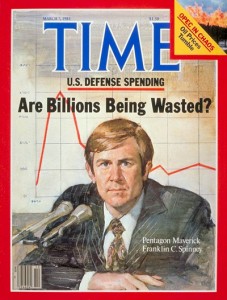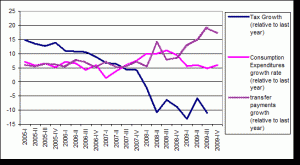
The failure of the so-called Super-Committee to come up with a plan for reducing the federal deficit has put the automatic sequestration process into play, at least for the time being. If executed, sequestration will impose arbitrary across-the-board spending cuts in the belief that reduced federal spending will reduce the deficit and reverse our economic malaise.
That a brute-force sequester will improve the economy is a contentious proposition, put it charitably. Opponents of the sequester argue that spending cuts by the federal government will depress demand and could even push the economy back into recession. The question of where the deficits are coming from is made doubly important by the threat of a sequester and the fact that we are on the cusp of a presidential election year.
No doubt, anticipating the collapse of the Super Committee, Congressman Chris Van Holland (D-MD), the ranking minority member of the House Budget Committee asked the Director of the Congressional Budget Office on 27 September to provide an estimate of portion of the deficit that is attributable to the economy's underutilization of capital and labour resources.
CBO's responded with a letter report hat estimated the federal deficit for 2012 would be one-third lower, or $630 billion instead of the $973 billion currently projected if the economy was running at full potential — see the attached pdf file.
I asked my friend Marshall Auerback, a financial commentator, for his evaluation of the CBO analysis.
Below, FYI, is Auerback's assessment to the CBO estimate.
——[Auerback Commentary]—–
CBO probably understates the effect of the recession on the deficit.. We do know that tax revenues as a percentage of GDP plunged in 2008.
Despite all the conservative uproar against Obama’s stimulus plan, the largest portion of the increase in the deficit has come from automatic stabilizers and not from discretionary spending. This is easily observable in the graph below which shows the rate of growth of tax revenues (automatic), government consumption expenditures (somewhat discretionary) and transfer payments (again automatic) relative to the same quarter of the previous year:

In 2005 tax revenues were humming, with a growth rate of 15% per year—far above GDP growth–hence, reducing nongovernment sector income—and above growth of government spending, which was just above 5%. Such fiscal tightening invariably results in a downturn because it serves to constrain demand (unless you pile on private sector debt, which is what we did in the 1990s and 2000s to an unprecedented degree). When it came, the budget deficits increased, mostly automatically.
While government consumption expenditures have remained relatively stable over the downturn (after a short spike in 2007-2008), the rate of growth of tax revenues has dropped sharply from a 5 % growth rate to a 10 % negative growth rate over just three quarters (from Q 4 of 2007 to Q 2 of 2008), reaching another low of -15% in Q1 of 2009. Transfer payments, as expected, have been growing at an average rate of 10% since 2007. Decreasing taxes coupled with increased transfer payments have automatically pushed the budget into a larger deficit, notwithstanding the flat consumption expenditures.
These automatic stabilizers and not the bailouts or much-belated and smaller-than-needed stimulus are the reason why the economy hasn’t been in a freefall a la the Great Depression. As the economy slowed down, the budget automatically went into a deficit putting a floor on aggregate demand.
As estimated by the New York Times, even if we were to eliminate welfare payments, Medicaid, Medicare, military spending, earmarks, social security payments, and all programs except for entitlements, and in addition stopped the stimulus injections, shut down the education department, got rid of a number of other things and doubled corporate taxes on top of all of this, the budget deficit would still be over 400 billion.
This further demonstrates the non-discretionary nature of the budget deficit. And of course this doesn’t take into consideration how much more tax revenues would fall and transfer payments would rise if these cuts were to be undertaken.
With the current automatic stabilizers in place, the budget cannot be balanced, and attempts to do so will only cause damage to the real economy as incomes and employment fall.
Marshall Auerback.
Phi Beta Iota: Emphasis added.



